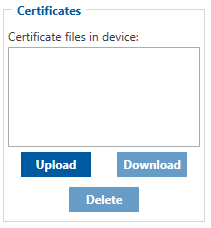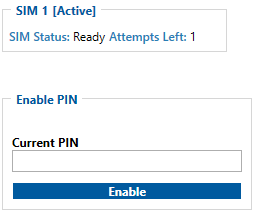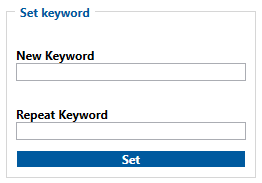TFT100 Security info
In security section user can see SIM card security information, "Teltonika" Configurator Keyword security information and SSL/TLS Certificate information.
SIM Card
Keyword Settings
Certificates

TFT100 can use digital certificates for authenticated access to secured network services.
Supported certificates file types: *.pem, *.pem.crt, *.key
| NOTE! | These features will only show up in configurator when device is connected to a computer. |
Some services (such as OpenVPN, MQTT, etc.) on Teltonika Mobility devices can be secured using TLS for encryption and authentication. This page discusses where one can obtain TLS certificates and key for this purpose.
What is TLS/DTLS ?
Transport Layer Security (TLS) aims primarily to provide privacy and data integrity between user (device) and server, where it negotiates the message cryptography, it authenticates code keys to ensure a safe data transfer.
Datagram Transport Layer Security (DTLS) is a communications protocol designed to protect data privacy and preventing eavesdropping and tampering. It is based on the Transport Layer Security (TLS) protocol, which is a protocol that provides security to computer-based communications networks.
The main difference between DTLS and TLS:
- Datagram Transport Layer Security (DTLS) uses User Datagram Protocol (UDP)
- Transport Layer Security (TLS) uses Transmission Control Protocol (TCP).
Why does traffic encryption matter?
1) It prevents a man-in-the-middle attack. TLS encryption turns structured data into randomized noise which makes it impossible to pull anything usable out of it.
2) It prevents data injection. TLS connection implies an initial handshake so the connection will be closed if certificates mismatch.
3) Traffic encryption is better than no traffic encryption. TLS allows and guarantees data exchange in a safe and private environment between two entities, user and server.
Certificate generation
Certificates secure client and server identities. After root certificates are installed, certificates get added to the root trust stores to secure connections between users and hosts, including devices and application users.
If you are using a third party service that requires TLS, all necessary files should be provided by the provider of that service. However, if you are setting up your own solution you may find use in of the TLS certificate generation methods described below.
Computer
You can also use third party software to generate the certificates on your computer. Guides are available for:


